PIB Summary - 23rd July 2025 | PIB (Press Information Bureau) Summary - UPSC PDF Download
PM JUGA – India’s Largest Tribal Village Development Scheme
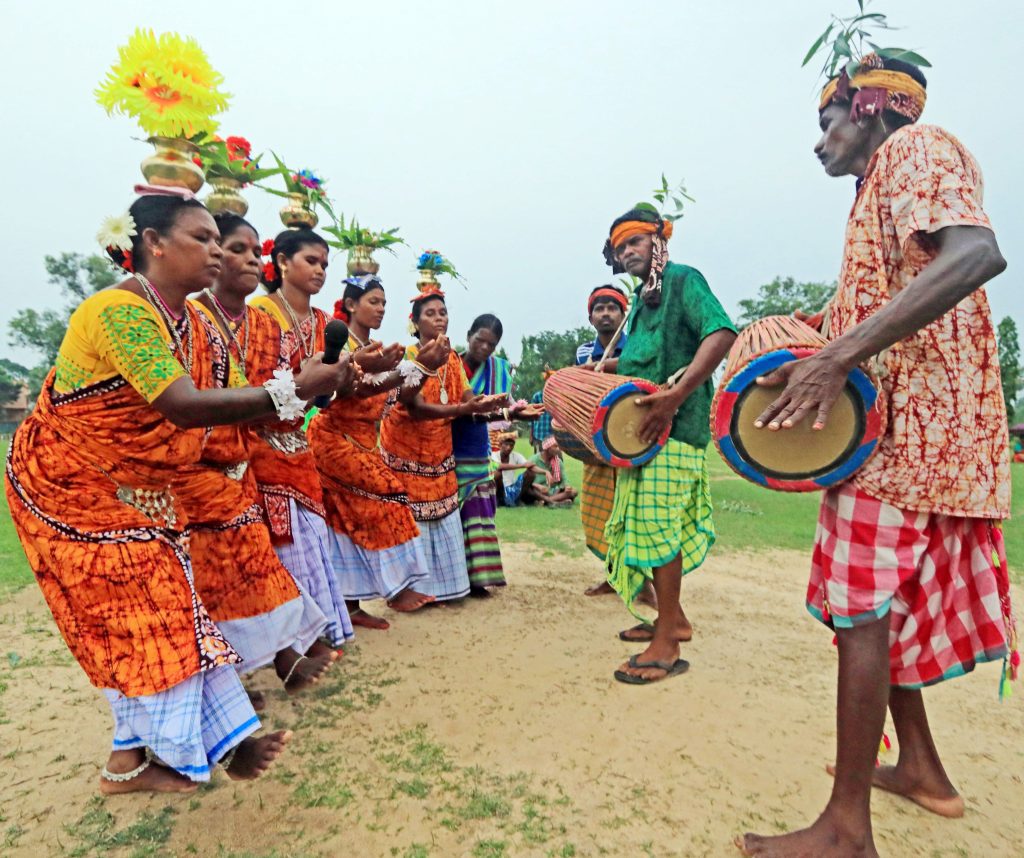
Context and Significance
- Launched: October 2, 2024, from Hazaribagh, Jharkhand.
- Objective: Comprehensive development of over 63,000 tribal-majority villages, benefiting around 5 crore tribal people (approximately 50% of India’s Scheduled Tribe population).
- Nodal Ministry: Ministry of Tribal Affairs, in collaboration with 17 other ministries.
- Total Budget: ₹79,156 crore (Centre: ₹56,333 crore; States: ₹22,823 crore).
- Geographic Reach: 549 districts, covering about 71% of Indian districts.
- Relevance: GS 1 (Society), GS 2 (Social Justice).
Coverage Criteria
- Villages with: Minimum 500 population and at least 50% tribal residents.
- Villages in Aspirational Districts: Minimum 50 tribal residents.
Sectoral Interventions – Converging Flagship Schemes
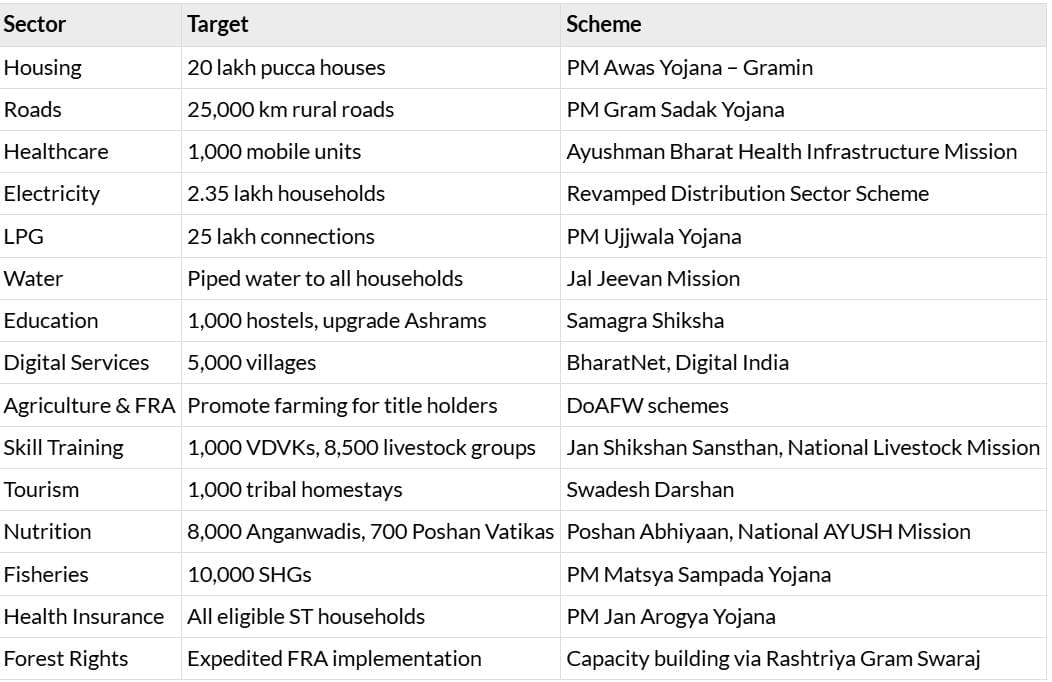
Alignment with Sustainable Development Goals (SDGs)
- SDG 3: Mobile health units, Anganwadis, Poshan Vatikas.
- SDG 4: Hostels, tribal schools, Ashram school upgrades.
- SDG 8: Tribal marketing centres, tourism, pisciculture.
- SDG 9: Roads, housing, digital infrastructure, electricity, LPG, tap water.
Case Study: Bairlutygudem, Andhra Pradesh
- Issue: Chronic water scarcity and hazardous treks through wildlife zones for water.
- Solution: Provision of tap water through the Jal Jeevan Mission.
- Outcome: Village Water & Sanitation Committee, led by women, now maintains water systems. Community ownership model successfully replicated in other tribal hamlets.
Comparison: PM JUGA vs PM JANMAN

Decade of Tribal Welfare: Key Achievements
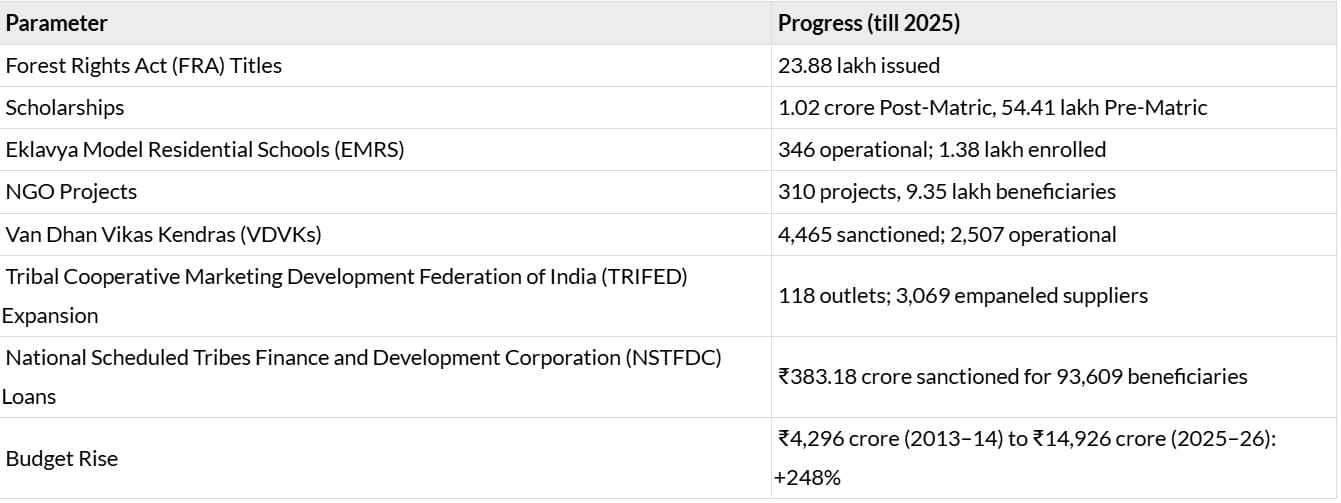
Cultural Empowerment
- Janjatiya Gaurav Divas: Celebrated on November 15, marking Birsa Munda’s birthday. In 2024, it will commemorate the 150th anniversary with over 1 crore participants and 46,000 events across India.
- Tribal Freedom Fighter Museums: 11 museums sanctioned to honor tribal freedom fighters.
- Tribal Research Institutes (TRIs):. new Tribal Research Institutes established post-2014 to promote tribal research and culture.
Governance and Monitoring Framework
- Gram Sabha Empowerment: Strengthening Gram Sabhas for processing FRA claims and capacity-building of Panchayati Raj Institution (PRI) members.
- Management Information System (MIS) and Dashboard: Implementing real-time tracking of scheme implementation across various ministries.
- Convergence Model: Using PM JUGA as a template for integrating tribal concerns into national programs.
Critical Analysis

Particularly Vulnerable Tribal Groups (PVTGs)
Who are PVTGs?
- PVTGs are a subset of Scheduled Tribes in India, recognized for being the most vulnerable and marginalized. They are identified based on specific criteria, including:
- Pre-agricultural level of technology: PVTGs use primitive technology for their livelihood.
- Stagnant or declining population: Their population is either stable or decreasing, indicating vulnerability.
- Extremely low literacy: PVTGs have very low literacy rates, which affects their access to information and resources.
- Subsistence-level economy: Their economy is primarily based on subsistence activities, making them highly vulnerable to external changes.
Key Facts about PVTGs
- Number of PVTGs in India: There are 75 identified PVTGs across the country.
- Total Scheduled Tribes in India: Approximately 10.45 crore (as per Census 2011)
- Estimated PVTG population: Around 28 lakh individuals belong to PVTGs.
- States with highest PVTG presence:
- Odisha: 13 PVTGs
- Andhra Pradesh: 12 PVTGs
- Madhya Pradesh: 7 PVTGs
- Maharashtra: 3 PVTGs
- Jharkhand: 8 PVTGs
- Ministry responsible: The Ministry of Tribal Affairs (MoTA) is responsible for the welfare and development of PVTGs.
- PVTG-specific Scheme: The PM-JANMAN scheme, launched in 2023, focuses on the development and welfare of PVTGs.
Forest Rights Act, 2006
The Forest Rights Act, 2006, also known as the Scheduled Tribes and Other Traditional Forest Dwellers (Recognition of Forest Rights) Act, aims to rectify historical injustices faced by forest-dwelling communities in India. The Act recognizes their rights over forest land and resources, acknowledging their traditional dependence on these areas for livelihood and sustenance.
Purpose of the Forest Rights Act
- The primary purpose of the Forest Rights Act is to correct the historical wrongs done to forest-dwelling communities by recognizing and granting them legal rights over forest land and resources. The Act seeks to empower these communities by providing them with the legal framework to assert their rights and access the resources they traditionally depended on.
Types of Rights Under FRA

Conclusion
- PM JUGA signifies a major change in tribal development by focusing on convergence, data-driven planning, and culturally sensitive implementation.
- With a decade of increased investment behind it, the scheme positions India as a global leader in inclusive, tribal-centric development.
AI & Drone-Based Agricultural Transformation in India
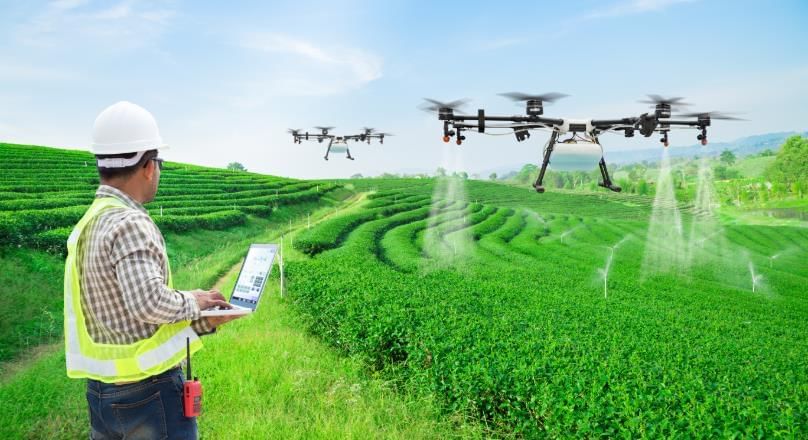
Policy Context & Relevance
India is leveraging advanced technologies like Artificial Intelligence (AI), the Internet of Things (IoT), and drone technology to bring about a significant transformation in the agricultural sector. The primary objectives of this initiative include:
- Increasing crop productivity
- Improving resilience to climate change
- Empowering small and marginal farmers
- Ensuring precision farming and optimal use of resources
Relevance: GS 3 (Agriculture, Technology)
Key AI-Driven Government Initiatives
(i) Kisan e-Mitra
- AI-Powered Voice Chatbot: Kisan e-Mitra is an AI-driven voice chatbot designed to assist farmers in real-time.
- Daily Queries: It handles over 20,000 farmer queries each day and has answered more than 95 lakh queries to date.
- Regional Language Support: The chatbot supports 11 regional languages, making it accessible to a wide range of farmers.
- Expansion of Services: Initially focused on the PM-Kisan scheme, Kisan e-Mitra is now expanding its services to cover other government schemes as well.
(ii) National Pest Surveillance System
- AI and Machine Learning: The National Pest Surveillance System utilizes AI, machine learning, and image recognition technology to identify over 400 pests across 61 different crops.
- Farmer Participation: Farmers can upload images of pests for identification, which promotes timely intervention and helps prevent crop loss.
- Extension Worker Utilization: The system is used by more than 10,000 extension workers, helping to mitigate crop loss linked to climate change.
(iii) Satellite-Based Crop Mapping
- Integration of Field Photos and Satellite Data: This initiative combines field photographs with satellite data to match crops with weather conditions.
- Real-Time Monitoring: It enables real-time monitoring of sown areas and the health of crops, facilitating better management practices.
Drone Promotion: Financial Architecture under SMAM
Sub-Mission on Agricultural Mechanization (SMAM)
- Objective: The initiative aims to promote the adoption of drones in agriculture through targeted subsidies for various purposes, including demonstration, individual ownership, and Custom Hiring Centres (CHCs).
- Beneficiary and Subsidy Rates:Different beneficiaries are eligible for varying subsidy rates and maximum limits. For instance:
- ICAR/KVKs/SAUs/PSUs: 100% subsidy up to ₹10 lakhs.
- FPOs (for demonstration): 75% subsidy with no maximum limit.
- CHCs (Cooperatives, FPOs, Entrepreneurs): 40% subsidy up to ₹4 lakhs.
- Individual Ownership (SC/ST/Women/NE): 50% subsidy up to ₹5 lakhs.
- Other Farmers: 40% subsidy up to ₹4 lakhs.
Namo Drone Didi: Women Empowerment via Drones
- Scheme Overview: Namo Drone Didi is a central sector scheme aimed at empowering women through the use of drones in agriculture.
- Time Frame and Budget: The scheme is planned for the period from 2023 to 2026, with a budget of ₹1,261 crore.
- Target and Subsidy: The goal is to distribute 15,000 drones to Women Self-Help Groups (SHGs) with an 80% subsidy (up to ₹8 lakhs). SHGs will cover 20% of the cost through Agri Infra Fund (AIF) loans with a 3% interest subvention.
- Drones Distributed: In the first year (2023-24), a total of 1,094 drones were distributed, with 500 under the Namo Drone Didi scheme.
- Objectives: The scheme aims to enhance women-led agri-services, reduce operational costs, and provide alternative livelihood options for women.
State-Wise Drone Distribution (As of July 2025)
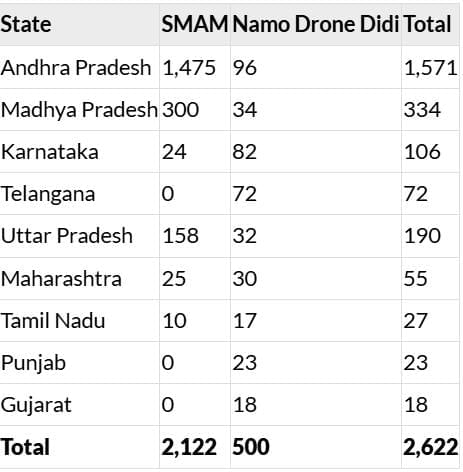
Top States: Andhra Pradesh, Madhya Pradesh, Uttar Pradesh, Karnataka, Telangana
Lagging States: Bihar, Assam, Nagaland, Manipur
Critical Evaluation
Strengths:
- Multi-Channel AI Interventions: The use of various AI-driven platforms ensures comprehensive support to farmers, addressing their queries and concerns effectively.
- Gender-Focused Drone Policy: The emphasis on empowering women through drone technology not only promotes gender equality but also enhances agricultural productivity.
- Real-Time Pest and Crop Health Monitoring: The ability to monitor pests and crop health in real-time allows for timely interventions, reducing potential crop losses.
- Decentralized Access: Involving Self-Help Groups (SHGs), Farmer Producer Organizations (FPOs), and Custom Hiring Centres (CHCs) ensures that the benefits of these technologies are accessible to all farmers, regardless of their location.
Challenges:
- Limited AI Literacy: Many farmers may not be familiar with AI technologies, hindering their ability to use these tools effectively.
- Dependence on State-Level Implementation: The success of these initiatives largely depends on the capacity and willingness of state governments to implement them effectively.
- Internet Connectivity Issues: Patchy broadband and internet connectivity in rural areas can limit the effectiveness of AI and drone technologies, which rely on stable internet access.
- Data Privacy Concerns: The use of image and voice data for monitoring and assistance raises concerns about data privacy and potential misuse of personal information.
Conclusion
- India’s initiative to integrate AI and drone technology into agriculture marks a significant shift towards precision farming, climate resilience, and inclusive agricultural growth.
- Initiatives like Kisan e-Mitra and Namo Drone Didi reflect the synergy of Digital India, Skill India, and Atmanirbhar Bharat in transforming the agricultural landscape.
FAQs on PIB Summary - 23rd July 2025 - PIB (Press Information Bureau) Summary - UPSC
| 1. What is the PM JUGA scheme and what are its main objectives? |  |
| 2. How does the AI and drone-based agricultural transformation work in India? |  |
| 3. What are the expected benefits of integrating AI and drone technology in agriculture? |  |
| 4. How does the government plan to implement the PM JUGA scheme effectively? |  |
| 5. What role do tribal communities play in the success of the PM JUGA scheme? |  |
















